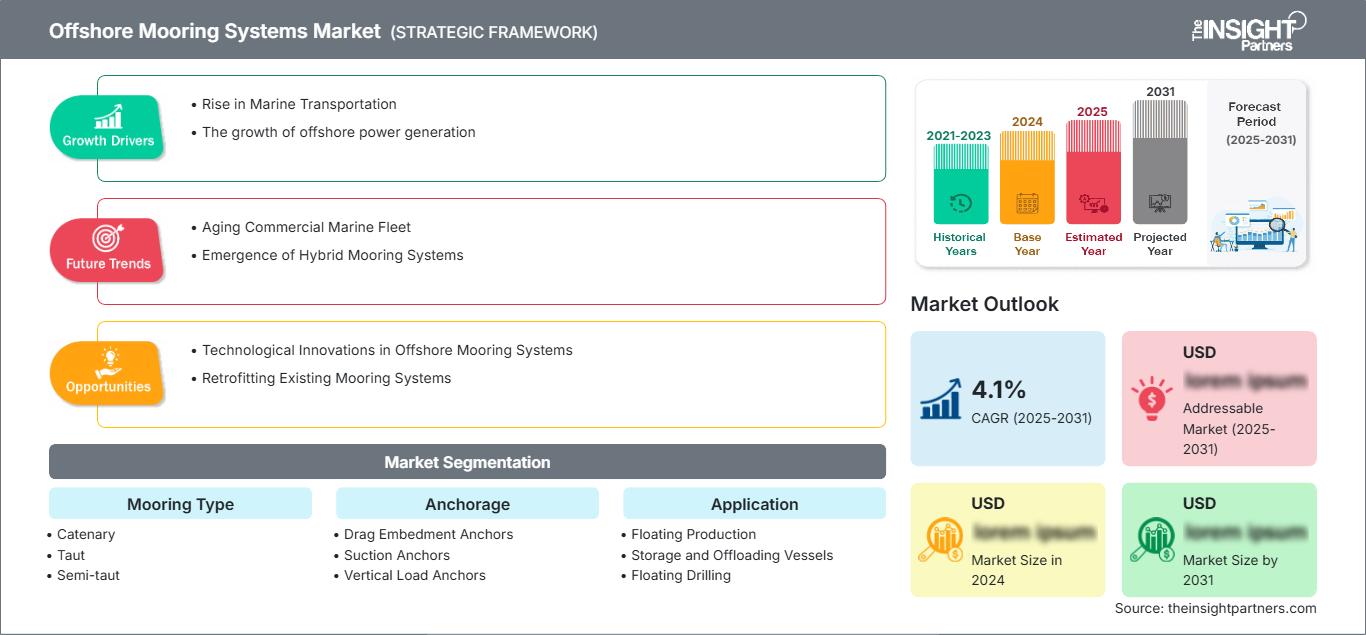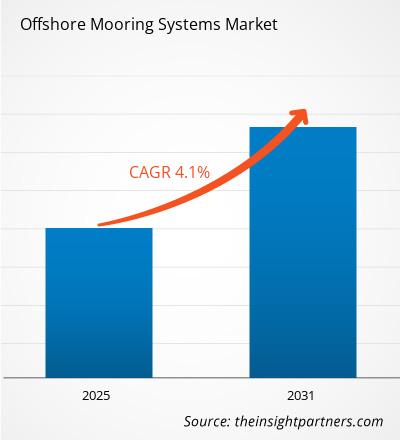Si prevede che il mercato dei sistemi di ormeggio offshore registrerà un CAGR del 4,1% dal 2025 al 2031, con una dimensione del mercato in espansione da XX milioni di dollari USA nel 2024 a XX milioni di dollari USA entro il 2031.
Il rapporto è segmentato per tipo di ormeggio (catenario, teso, semi-teso, allargato, a punto singolo e posizionamento dinamico), ancoraggio (ancoraggi a trascinamento, ancoraggi a ventosa e ancoraggi a carico verticale), applicazione (navi galleggianti di produzione, stoccaggio e scarico (FPSO), navi galleggianti di perforazione, produzione, stoccaggio e scarico (FDPSO), navi galleggianti per gas naturale liquefatto (FLNG), piattaforme con gambe di tensione, semisommergibili, piattaforme Spar e altre). L'analisi globale è ulteriormente suddivisa a livello regionale e per i principali paesi. Il rapporto offre il valore in USD per l'analisi e i segmenti sopra indicati.
Scopo del rapporto
Il rapporto "Offshore Mooring Systems Market" di The Insight Partners mira a descrivere il panorama attuale e la crescita futura, i principali fattori trainanti, le sfide e le opportunità. Ciò fornirà spunti a vari stakeholder aziendali, come:
- Fornitori/produttori di tecnologia: per comprendere le dinamiche di mercato in evoluzione e conoscere le potenziali opportunità di crescita, consentendo loro di prendere decisioni strategiche informate.
- Investitori: per condurre un'analisi completa delle tendenze in merito al tasso di crescita del mercato, alle proiezioni finanziarie di mercato e alle opportunità esistenti lungo la catena del valore.
- Enti di regolamentazione: per regolamentare le politiche e le attività di controllo sul mercato con l'obiettivo di ridurre al minimo gli abusi, preservare la fiducia degli investitori e sostenere l'integrità e la stabilità del mercato.
Segmentazione del mercato dei sistemi di ormeggio offshore Tipo di ormeggio
- Catenaria
- Teso
- Semi-teso
- Disteso
- Punto singolo
- Posizionamento dinamico
Ancoraggio
- Ancore a trascinamento
- Ancore a ventosa
- Ancore a carico verticale
Applicazione
- Produzione galleggiante
- Navi di stoccaggio e scarico
- Perforazione galleggiante
- Produzione
- Navi di stoccaggio e scarico
- Navi galleggianti per gas naturale liquefatto
- Piattaforma con gambe di tensione
- Semisommergibili
- Piattaforme Spar
Geografia
- Nord America
- Europa
- Asia-Pacifico
- America meridionale e centrale
- Medio Oriente e Africa
Potrai personalizzare gratuitamente qualsiasi rapporto, comprese parti di questo rapporto, o analisi a livello di paese, pacchetto dati Excel, oltre a usufruire di grandi offerte e sconti per start-up e università
Mercato dei sistemi di ormeggio offshore: Approfondimenti strategici

-
Ottieni le principali tendenze chiave del mercato di questo rapporto.Questo campione GRATUITO includerà l'analisi dei dati, che vanno dalle tendenze di mercato alle stime e alle previsioni.
Fattori di crescita del mercato dei sistemi di ormeggio offshore
- Aumento del trasporto marittimo: la crescente preferenza per il trasporto marittimo è aumentata negli ultimi anni, poiché offre tariffe più economiche, è ideale per merci di grandi volumi e si collega facilmente con altre parti del mondo. Uno dei principali vantaggi del trasporto marittimo è la capacità delle compagnie di navigazione di spedire carichi pesanti e di grandi dimensioni, comunemente chiamati carichi breakbulk o carichi Not-in-trailer (NIT). Veicoli di grandi dimensioni, attrezzature, materiali da costruzione e altri articoli possono essere trasportati come merce. Pertanto, si prevede che l'aumento del trasporto marittimo guiderà il mercato dei sistemi di ormeggio offshore nei prossimi anni.
- Crescita della produzione di energia offshore: si prevede che l'aumento degli investimenti in progetti di energia eolica offshore, produzione di petrolio e gas offshore e progetti di energia oceanica stimolerà la domanda di navi, che a sua volta dovrebbe trainare la crescita del mercato dei sistemi di ormeggio offshore nei prossimi anni.
Tendenze future del mercato dei sistemi di ormeggio offshore
- Invecchiamento della flotta marittima commerciale: in quasi tutti i paesi, la maggior parte della flotta di navi commerciali è obsoleta. Secondo i dati pubblicati dalle Nazioni Unite nel 2023, l'età media delle navi a livello globale era di 22,2 anni e più della metà delle navi ha più di 15 anni. Inoltre, secondo i dati forniti dall'Ufficio dei Trasporti degli Stati Uniti nel 2021, negli Stati Uniti c'erano circa 27.000 navi con più di 15 anni. Pertanto, la necessità di sostituire la flotta commerciale aumenterà, il che si prevede creerà opportunità di crescita positive per il mercato dei sistemi di ormeggio offshore durante il periodo di previsione.
- Emergenza di sistemi di ormeggio ibridi: l'emergere di sistemi di ormeggio ibridi che combinano metodi di ormeggio tradizionali con tecnologie di posizionamento dinamico sta guadagnando terreno. Questa tendenza migliora la flessibilità operativa e l'adattabilità alle diverse condizioni ambientali.
Opportunità di mercato per i sistemi di ormeggio offshore
- Innovazioni tecnologiche nei sistemi di ormeggio offshore: nel corso dei decenni, i progressi tecnologici hanno portato a significativi miglioramenti nei sistemi di ormeggio. L'attenzione si è concentrata sull'aumento dell'efficienza, sulla riduzione delle dimensioni e sul miglioramento dell'affidabilità di questi sistemi. Questo cambiamento ha consentito una maggiore flessibilità ed efficienza nella generazione di energia per soddisfare i diversi requisiti di carico energetico a bordo delle navi. Pertanto, si prevede che le innovazioni tecnologiche rappresentino la tendenza chiave del mercato.
- Adeguamento dei sistemi di ormeggio esistenti: il potenziale di adeguamento dei sistemi di ormeggio offshore esistenti con tecnologie avanzate offre opportunità significative. Le aziende possono rivolgersi agli operatori che desiderano migliorare le prestazioni e la sicurezza delle loro attuali soluzioni di ormeggio.
Approfondimenti regionali sul mercato dei sistemi di ormeggio offshore
Le tendenze regionali e i fattori che influenzano il mercato dei sistemi di ormeggio offshore durante il periodo di previsione sono stati ampiamente spiegati dagli analisti di The Insight Partners. Questa sezione illustra anche i segmenti e la geografia del mercato dei sistemi di ormeggio offshore in Nord America, Europa, Asia-Pacifico, Medio Oriente e Africa, America meridionale e centrale.
Ambito del rapporto di mercato sui sistemi di ormeggio offshore
| Attributo del rapporto | Dettagli |
|---|---|
| Dimensioni del mercato in 2024 | US$ XX million |
| Dimensioni del mercato per 2031 | US$ XX Million |
| CAGR globale (2025 - 2031) | 4.1% |
| Dati storici | 2021-2023 |
| Periodo di previsione | 2025-2031 |
| Segmenti coperti |
By Tipo di ormeggio
|
| Regioni e paesi coperti |
Nord America
|
| Leader di mercato e profili aziendali chiave |
|
Densità degli operatori del mercato dei sistemi di ormeggio offshore: comprendere il suo impatto sulle dinamiche aziendali
Il mercato dei sistemi di ormeggio offshore è in rapida crescita, trainato dalla crescente domanda degli utenti finali, dovuta a fattori quali l'evoluzione delle preferenze dei consumatori, i progressi tecnologici e una maggiore consapevolezza dei vantaggi del prodotto. Con l'aumento della domanda, le aziende stanno ampliando la propria offerta, innovando per soddisfare le esigenze dei consumatori e sfruttando le tendenze emergenti, alimentando ulteriormente la crescita del mercato.

- Ottieni il Mercato dei sistemi di ormeggio offshore Panoramica dei principali attori chiave
Punti di forza
- Copertura completa: il rapporto analizza in modo esaustivo prodotti, servizi, tipologie e utenti finali del mercato dei sistemi di ormeggio offshore, fornendo un panorama olistico.
- Analisi degli esperti: il rapporto è redatto sulla base della conoscenza approfondita di esperti e analisti del settore.
- Informazioni aggiornate: il rapporto garantisce la pertinenza aziendale grazie alla copertura di informazioni e dati recenti.
- Opzioni di personalizzazione: questo rapporto può essere personalizzato per soddisfare le esigenze specifiche del cliente e adattarsi in modo appropriato alle strategie aziendali.
Il rapporto di ricerca sul mercato dei sistemi di ormeggio offshore può quindi contribuire a guidare il percorso di decodificazione e comprensione dello scenario del settore e delle prospettive di crescita. Sebbene possano esserci alcune valide preoccupazioni, i vantaggi complessivi di questo rapporto tendono a superare gli svantaggi.
- Analisi storica (2 anni), anno base, previsione (7 anni) con CAGR
- Analisi PEST e SWOT
- Valore/volume delle dimensioni del mercato - Globale, Regionale, Nazionale
- Industria e panorama competitivo
- Set di dati Excel
Report recenti
Testimonianze
Motivo dell'acquisto
- Processo decisionale informato
- Comprensione delle dinamiche di mercato
- Analisi competitiva
- Analisi dei clienti
- Previsioni di mercato
- Mitigazione del rischio
- Pianificazione strategica
- Giustificazione degli investimenti
- Identificazione dei mercati emergenti
- Miglioramento delle strategie di marketing
- Aumento dell'efficienza operativa
- Allineamento alle tendenze normative






















 Ottieni un campione gratuito per - Mercato dei sistemi di ormeggio offshore
Ottieni un campione gratuito per - Mercato dei sistemi di ormeggio offshore